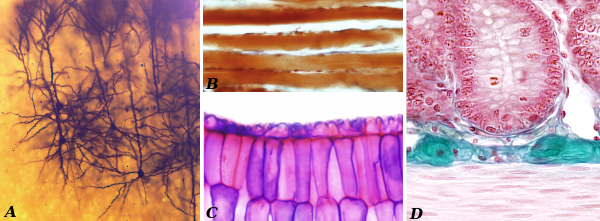Cells show a great diversity of forms and functions. Because of this, it was not easy to realize that all living organisms are made up of units that shares a common basic structure. Every unit is a cell. The other major issue for the discovering of the cell was the very small size they usually show.
1. Cell size
Cell size is measured in micrometers (µm). One micrometer, or micron, is one thousandth of a millimeter (10-3 mm), and one millionth of a meter (10-6 m). A typical eukaryote cell is between 10 and 30 µm in size. This is true for the cells of a worm and for those of an elephant, but there are many more cells in the elephant. To be aware of how small the cells are, imagine a 1.70 meters tall person which is stretched to equal the height of the Everest, which is about 8500 meters. The stretched giant cells of that person would measure only 1.3 centimeters, i.e., smaller than one euro cent coin (then, it would be a giant made up of a huge amount of euro cent coins).
However, there are eukaryote cells that show unusual dimensions (Figure 1). They can be very small, such as sperm cells, whose head may be less than 4 µm in diameter, while others, like the eggs of some birds and reptiles, may be larger than 10 centimeters (thousands of microns) in their larger axis, but we must measure only the yolk, since the egg white is not part of the cell. An extreme example is the egg of ostriches. Some cells may have cytoplasmic extensions as long as several meters, such as some neurons in the brain of giraffes that innervate the most caudal part of the spinal cord. Smaller than eukaryote cells are prokaryote cells, which are typically around 1 to 2 µm in diameter, and Mycoplasma being the smallest with about 0.5 µm in diameter.

2. Number
Most living organisms are unicellular, i.e., a single independent cell. Prokaryotes (bacteria and archaea) are the most abundant unicellular organisms. Unicellular eukaryote species are abundant too. Organisms that can be observed without microscopes are mostly multicellular, i.e., they are made up of many cells. Multicellular organisms are animals, plants, fungi and some algae. In general, larger multicellular organisms contain higher number of cells since they have a similar average cell size. However, there are examples where the increase in size is got by increasing the cell size. Estimates of the total number of cells in an organism similar in size to a human being may range from 1013 (1 followed by 13 zeros) to 1014 (1 followed by 14 zeros). To be aware of these numbers, the total number of cells in the human brain is estimated to be about 86x109 neurons and that of a mouse brain is about 15x109. The most abundant cells of the human body are red blood cells and glial/neuronal cells of the nervous system. Nonetheless, the total number of prokaryote cells largely exceeds the number of eukaryote cells. It is enough to point out that the number of prokaryote cells that live in our body is larger than our own cells.
3. Morphology
Cell morphology is typically depicted as rounded, but this is probably the most uncommon shape (except for a few types of cells). Cell morphology in animal tissues is diverse, enormously diverse! It can vary from rounded to star-like, from multi-lobed to filiform. Plant cells also show a wide diversity of forms, which is determined by the cell wall, with cuboidal and columnar being the most common shapes. See some examples in Figure 2. The cell morphology diversity made it difficult to realize that all leaving organisms are made up of cells, that is, the cell theory.

4. Function
Unicellular organisms are diverse in morphology and live in many different environments. They need to perform all the tasks or functions to survive and for reproduction. A pluricellular organism needs to carry out similar functions, but a function is performed by many cells. They are many specialized cells in the organism that work coordinately. These functions are extremely complex and diverse, and include food digestion, detoxification, movement, reproduction, support, defense against pathogens, and those related to thinking, emotions or consciousness. All these functions are carried out by specialized cells, such as those of the gastrointestinal epithelium, liver, muscle, germ cells, bone, lymphocytes and neurons, respectively. Cells need a particular molecular framework, mainly based on proteins, to carry out their functions. In a organism, some functions can be carried out by only one cell type, but it commonly requires the cooperation of several cell types acting in a coordinated manner. In some cases, the cell has to die to perform the function, as it is the case for the cells that form the nails, or the cells of xylem, which conduct the sap in plants.
 Introduction
Introduction